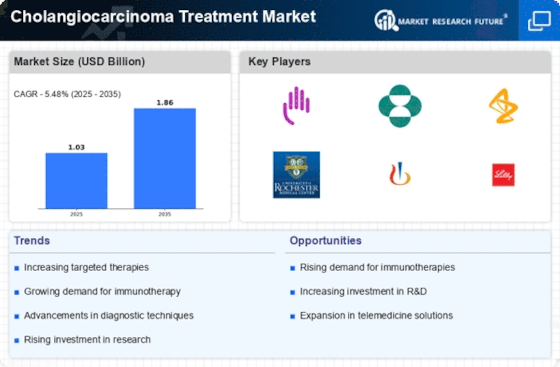Emergence of Personalized Medicine
The emergence of personalized medicine is reshaping the Cholangiocarcinoma Treatment Market. Tailored therapies that consider individual genetic profiles are becoming increasingly prevalent, allowing for more effective treatment strategies. This approach not only enhances patient outcomes but also minimizes adverse effects associated with traditional therapies. The market is witnessing a shift towards precision oncology, where treatments are designed based on specific molecular characteristics of the tumor. This trend is likely to drive investment in research and development, as pharmaceutical companies seek to create targeted therapies that cater to the unique needs of cholangiocarcinoma patients. As personalized medicine continues to gain traction, it is expected to play a crucial role in the evolution of the Cholangiocarcinoma Treatment Market.
Advancements in Diagnostic Techniques
Advancements in diagnostic techniques are significantly influencing the Cholangiocarcinoma Treatment Market. Enhanced imaging technologies, such as MRI and CT scans, along with the development of biomarkers, have improved early detection rates of cholangiocarcinoma. Early diagnosis is crucial, as it allows for timely intervention and better treatment outcomes. The integration of these advanced diagnostic tools is likely to lead to an increase in the number of patients seeking treatment, thereby expanding the market. Furthermore, as diagnostic capabilities continue to evolve, they may facilitate the identification of cholangiocarcinoma at earlier stages, which could potentially enhance the efficacy of available therapies within the Cholangiocarcinoma Treatment Market.
Increase in Cholangiocarcinoma Incidence
The rising incidence of cholangiocarcinoma is a pivotal driver for the Cholangiocarcinoma Treatment Market. Recent data indicates that the annual incidence of this malignancy is increasing, with estimates suggesting that it affects approximately 2 to 3 individuals per 100,000 people. This upward trend in cases necessitates the development and availability of effective treatment options, thereby propelling market growth. As awareness of cholangiocarcinoma improves, more patients are being diagnosed, which in turn stimulates demand for innovative therapies. The increasing burden of this disease is likely to encourage pharmaceutical companies to invest in research and development, ultimately leading to a broader range of treatment modalities within the Cholangiocarcinoma Treatment Market.
Rising Awareness and Education Initiatives
Rising awareness and education initiatives regarding cholangiocarcinoma are contributing to the growth of the Cholangiocarcinoma Treatment Market. Increased public and professional awareness about the disease is leading to earlier diagnosis and treatment. Educational campaigns aimed at healthcare providers and the general public are crucial in disseminating information about risk factors, symptoms, and the importance of early detection. As awareness grows, more patients are likely to seek medical attention, which could result in a higher demand for treatment options. This trend is expected to foster a more informed patient population, ultimately driving the expansion of the Cholangiocarcinoma Treatment Market as healthcare systems adapt to meet the needs of these patients.
Growing Investment in Research and Development
Growing investment in research and development is a critical factor propelling the Cholangiocarcinoma Treatment Market. Increased funding from both public and private sectors is facilitating the exploration of novel therapeutic options and clinical trials. This influx of capital is essential for advancing the understanding of cholangiocarcinoma and developing innovative treatments. As more resources are allocated to research initiatives, the likelihood of discovering effective therapies increases, which could significantly impact patient care. Furthermore, collaborations between academic institutions and pharmaceutical companies are likely to enhance the pace of innovation within the Cholangiocarcinoma Treatment Market, ultimately benefiting patients and healthcare providers alike.

















Leave a Comment